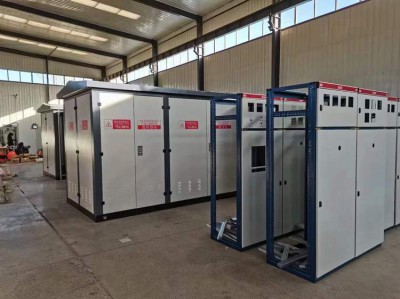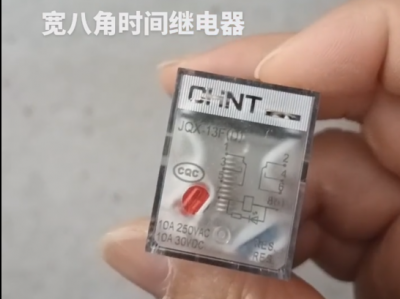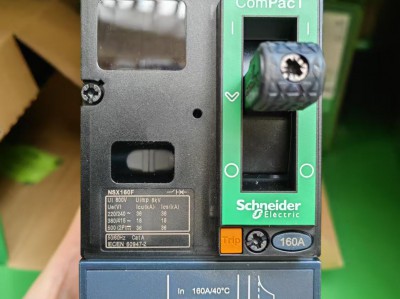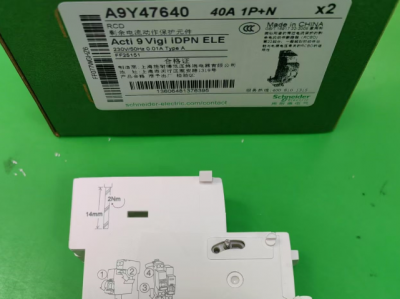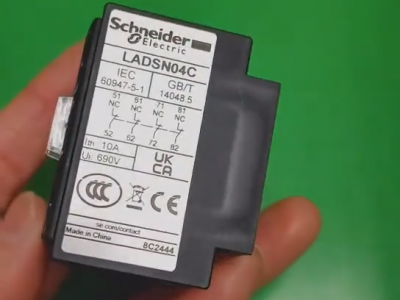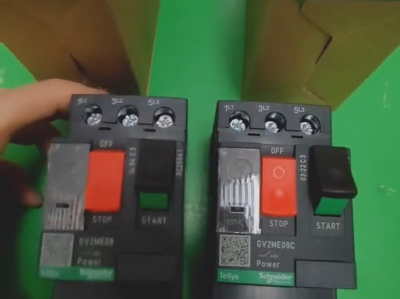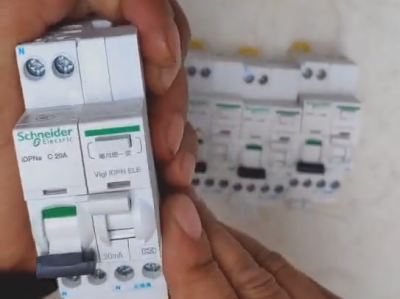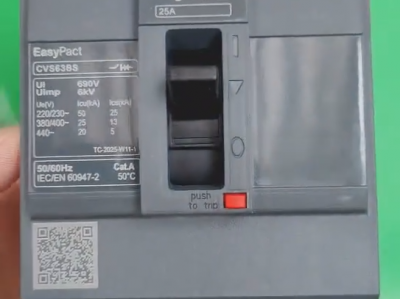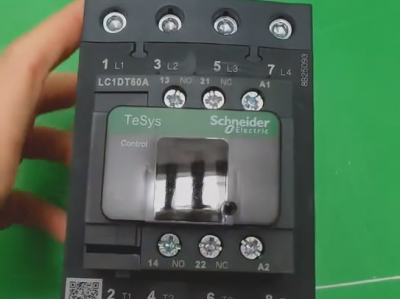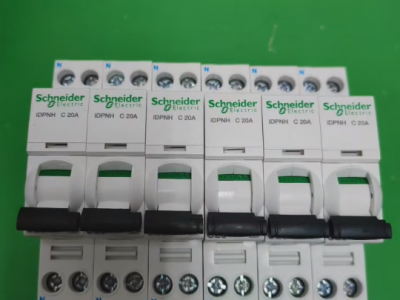Schneider Electric IC65N-3PC16A
Product description
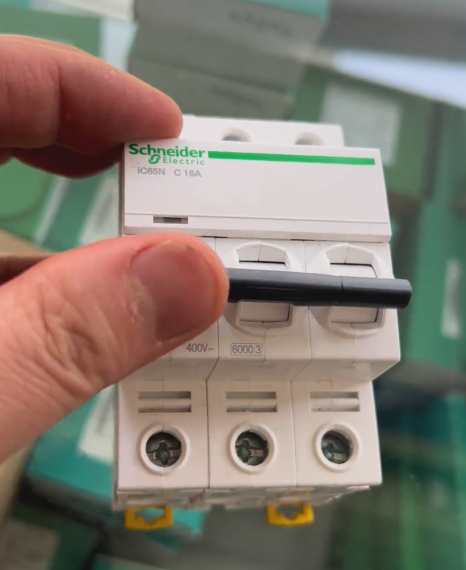
The IC65N-3PC16A from Schneider Electric is a Miniature Circuit Breaker (MCB) specifically designed for end - of - line power distribution. It is suitable for protecting three - phase circuits against overload and short - circuit damage. Below is a detailed analysis of its core parameters, application scenarios, and key selection points:
1. Model Meaning and Core Parameters
1.1 Model Breakdown
IC65: Represents the Schneider Acti9 series of miniature circuit breakers, with a frame rating current of 63A.
N: Indicates the breaking capacity class. The N - type has a breaking capacity of 6kA (at 230/400V AC).
3P: Denotes a three - pole design, which is used in three - phase four - wire or three - phase three - wire circuits and can disconnect three phase lines simultaneously.
C16A: Refers to a Type C tripping curve and a rated current of 16A. It is suitable for loads with moderate inrush currents, such as lighting and sockets.
1.2 Key Electrical Parameters
Rated Voltage: 230/400V AC, supporting a frequency of 50/60Hz.
Tripping Characteristics:
Overload Protection: Achieved through the thermal effect of a bimetallic strip. It trips in approximately 30 seconds when the current reaches 1.5 times the rated current (24A).
Short - Circuit Protection: The electromagnetic trip unit acts instantaneously when the current is 5 - 10 times the rated current (80 - 160A).
Breaking Capacity:
Icu (Ultimate Short - Circuit Breaking Capacity): 6kA (at 400V AC), which meets the short - circuit protection requirements in residential and small - scale commercial scenarios.
Ics (Service Short - Circuit Breaking Capacity): 6kA (100% of Icu), ensuring that the circuit breaker can still be used after a short - circuit occurs.
1.3 Physical Characteristics
Dimensions: It has a width of 54mm (6 modules) and is suitable for installation on a 35mm DIN rail, saving space in the distribution box.
Protection Class: IP20 (for the terminal part), preventing accidental contact with live components.
Service Life: It has a mechanical life of 20,000 operations and an electrical life of 10,000 operations, ensuring high long - term reliability.
2. Application Scenarios and Load Matching
2.1 Typical Application Fields
Residential Power Distribution: Used for protecting the circuits of high - power electrical appliances such as three - phase air conditioners and electric water heaters.
Commercial Buildings: Applied in the lighting systems of offices and shopping malls, as well as for small three - phase equipment (e.g., elevator control circuits).
Industrial Scenarios: Suitable for end - of - line power distribution lines of automated production lines and small motors. However, it should be noted that the Type C curve may not be suitable for high - inrush current loads (e.g., directly started motors).
2.2 Load Selection Recommendations
Loads Suitable for Type C Curve:
- Lighting fixtures (incandescent lamps, LED lamps, etc.).
- Ordinary sockets (for computers, televisions, small household appliances).
- Resistive loads (electric heaters, water dispensers).
Scenarios to Avoid:
- Motors (the starting current can reach 5 - 10 times the rated current, which may cause false tripping).
- Inductive loads such as welding machines and compressors (a Type D curve is recommended).
3. Installation and Expansion Functions
3.1 Installation Method
Rail Installation: It can be directly fixed on a standard 35mm DIN rail using the snap - fit on the back. It supports both top and bottom wire entry, with a wiring torque of 2.5N·m.
Wiring Capacity: It can accommodate single - core hard wires (1 - 25mm²) or flexible wires (1 - 16mm²). The tunnel - type terminal design ensures a reliable connection.
3.2 Accessory Expansion
Earth Leakage Protection: It can be assembled with a Vigi IC65 earth leakage module (e.g., Vigi C16A) to provide 30mA residual current protection. It is suitable for humid environments such as bathrooms and kitchens.
Status Monitoring:
OF Auxiliary Contact: Feeds back the on/off status of the circuit breaker through normally open/normally closed signals, and is used for remote monitoring or PLC systems.
SD Alarm Contact: Triggers an alarm when a fault trip occurs, facilitating quick location of the faulty circuit.
Control Functions:
MX Shunt Trip: Controls the circuit breaker to open remotely (e.g., for fire alarm linkage).
MN Undervoltage Trip: Automatically disconnects the circuit when the voltage is abnormal, protecting sensitive equipment.
4. Certification and Compliance
International Certifications: It complies with IEC 60898 - 1 (Circuit Breakers for Household and Similar Purposes) and GB 10963.1 (Chinese Standard). It has obtained CCC and CE certifications, ensuring its applicability in the global market.
Environmental Adaptability:
- Operating Temperature: - 35°C to + 70°C, suitable for wide - temperature environments.
- Pollution Degree Resistance: Class 3, enabling stable operation in general industrial environments.
5. Key Selection Considerations
5.1 Current Matching
- The rated current (16A) should be greater than the maximum continuous load current of the circuit. It is recommended to calculate based on the load power (e.g., for three - phase loads: Power = √3 × Voltage × Current × Power Factor).
- Avoid Overload: For example, the maximum resistive load that a 16A circuit breaker can handle is approximately 10.5kW (400V × 16A × 1.5).
5.2 Verification of Breaking Capacity
- Ensure that the prospective short - circuit current at the installation location does not exceed 6kA. If the short - circuit risk is high (e.g., near a transformer), a type with higher breaking capacity such as H - type (10kA) or L - type (15kA) should be selected.
5.3 Earth Leakage Protection Requirements
- For locations sensitive to personal safety (e.g., residential bathrooms, outdoor equipment), an earth leakage module (Vigi) should be used together, rather than relying solely on the overload/short - circuit protection of the circuit breaker itself.
6. Price and Market Reference
Price: A single - pole circuit breaker (1P C16A) costs approximately 30 - 50 yuan, and a three - pole model (3P C16A) ranges from 80 to 120 yuan. The specific price varies depending on the purchasing channel and quantity.
Cost - Effectiveness Advantage: Compared with competing products, the IC65N series is renowned for its high reliability, modular design, and wide accessory compatibility. It is suitable for projects with high requirements for stability and expandability.
7. Summary
The Schneider IC65N - 3PC16A is a three - phase circuit breaker with balanced performance. Relying on its 6kA breaking capacity, Type C tripping curve, and flexible accessory expansion, it has become an ideal choice for end - of - line power distribution in residential, commercial, and light industrial applications. When selecting, a comprehensive evaluation should be conducted based on the load type, short - circuit risk, and functional requirements. Priority should be given to purchasing through formal channels to ensure product quality and after - sales support.

